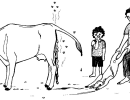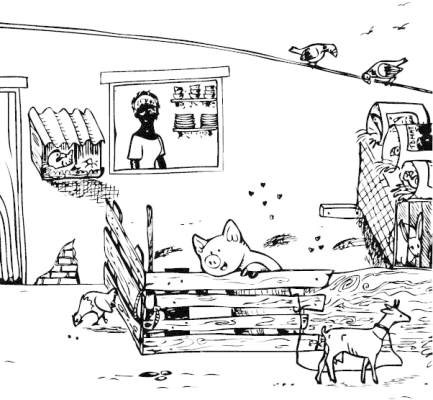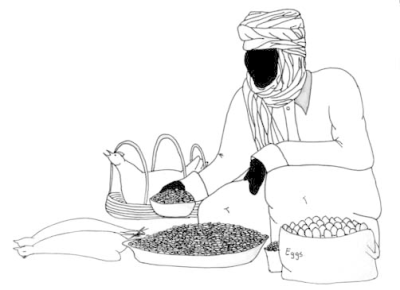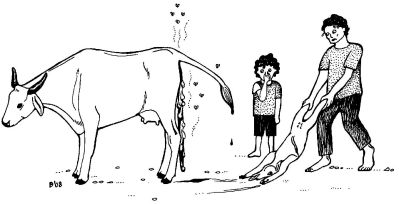
|
The impact of zoonoses on daily life
|
| The role of poverty | The role of wildlife and vermin or pests | |||
| Importance of zoonoses in rural areas | Information Source Links | |||
| Zoonoses in urban areas |
The role of poverty
Poverty is an important factor governing the risk of zoonotic diseases
in rural and urban areas. Poverty can increase exposure to such infections
and reduces the chances of getting rid of diseases. Poor communities
are often trapped in a never-ending cycle known as "the devil's
circle of poverty".
Poor people are more likely to suffer from zoonotic diseases for several
reasons:
- Poor education: if you do not know that certain diseases exist, you will be less motivated to prevent them.
- Poor sanitary conditions: lack of knowledge and lack of money to build good sanitary systems.
- Cheaper animals are often less healthy animals. Cheaper meat is never the healthiest meat and often has not been inspected, therefore, it has a greater risk of harbouring microbes that can make you ill.
- Poor veterinary and public health services: lack of veterinary services worsens the situation in rural communities for those who cannot pay for private services.
- Poor people are often less well nourished and less healthy and are more susceptible to infectious disease in general and zoonoses in particular.
- Lack of money to set up a good health system for both animals and humans.
Many zoonoses cause disabling diseases in humans. A sick or disabled
person cannot work as much or as well as a healthy person, hence will
not earn enough money to buy proper food or healthy livestock. Unhealthy
livestock produce less food. The result is less food to eat and
less food to sell - less income again and not enough money to buy medicines or to pay for proper education or healthy livestock? The
big challenge is to break out of this circle through simple and low-cost
methods and means.
Importance of zoonoses in rural areas
The main difference between rural livestock keeping and urban livestock
keeping is experienced in accessibility to health services, affecting
both humans and animals. The more remote the area the less access
there is to public health care and veterinary care.
Close contact between domestic animals and humans is a characteristic
of rural settings. Animals kept for food production in these areas
have an economic value as well: animals can be sold and they can be a
source of security. It is this close association that makes zoonotic diseases
so vitally important in rural areas.
In general, three types of animal raising and keeping can be found in
rural areas:
1) Pastoralists and herders
2) A more sedentary, small-scale system
3) Commercial, large-scale animal production.
1) Pastoralists and herders
2) A more sedentary, small-scale system
3) Commercial, large-scale animal production.
Each system has its own advantages and disadvantages with regard to
the risk of zoonotic diseases. An advantage of a large-scale system is
that diseases are easier to keep out of the stable, whereas in smallscale
systems there is more interaction between the animals and the
outside world. The disadvantage is that when one animal is infected
the disease can spread rapidly through a large-scale farm, because of
the many animals living in close proximity under one roof. In this
situation, small-scale systems have the advantage: fewer animals living
close together so the chance that a sick animal infects another
animal is relatively small. Detection is also easier.
| Box 5: "Bad" meat
People in poor rural communities often eat infected meat or meat from animals
that are found dead.
A study in Ghana showed that 240 out of 250 interviewed cattle owners,
butchers and consumers knew about anthrax and the signs of the disease.
But none of them knew that the microbe that causes anthrax could be transmitted
from dead cows to humans. 225 persons knew that eating meat from
cattle that had died from ?unnatural causes? could be fatal to humans. Still, 25
persons thought that there was no risk at all, and although 42 persons thought
there was a risk, they felt that anthrax could be prevented by eating certain
herbs (which is not the case). Moreover, beef is expensive and a good source
of protein, so people find it wasteful not to eat the meat.
Source: Human behavioural factors implicated in outbreaks of human anthrax
in the Tamale municipality of northern Ghana. Opare C, Nsiire A, Awumbilla B,
Akanmori BD. Acta Trop. 2000; 76:49-52.
|
Other factors that can enhance the occurrence of zoonotic diseases in
rural areas include the following:
1) There is a far greater likelihood of contact between livestock and
wildlife in rural areas. Some zoonoses can live in both livestock and
wildlife, which makes it difficult to get rid of these diseases. An example
of one such zoonosis is trypanosomiasis or sleeping sickness
in cattle.
2) Civil unrest and insecurity can increase movement of people and
their animals as they flee and return to their areas of habitation.
3) Certain development programmes promote inappropriate livestock
production systems affecting pastoralists, for instance, who are often
forced to settle instead of leading their usual nomadic life. They
are not accustomed to the new situation and to the risks a sedentary
life brings to their animals.
The importance of zoonotic diseases in rural areas extends beyond the
realm of public health. Apart from causing human disease and mortality,
they affect the agricultural production and social structures of a
community. Zoonotic diseases decrease the availability of food creating
local and international trade barriers.
- Besides animal production, livestock keepers in rural areas often need their animals for other activities, such as an ox for ploughing or a donkey to take fruits to the market. A sick animal is of no use.
- Zoonotic diseases have a negative effect on animal production. Animals that carry a disease will give less milk, grow slower, stay smaller and lay fewer eggs. See chapter: Introduction
- Countries may set up trade restrictions for countries affected by a known zoonosis.
- The economic impact of zoonotic diseases is based on the economic value of the animals as well as the social well being of the rural communities.
- Zoonotic diseases also result in increased costs for controlling outbreaks.
Although zoonotic diseases are mentioned in the annual reports of
ministries of health and livestock in many developing countries, they
are rarely prioritized compared to other notable human and animal
diseases like malaria and rinderpest.
Zoonoses in urban areas
 |
| Backyard stable in the city. Small houses, stables and cage situated together. |
| © Agromisa Foundation and CTA, Wageningen, 2008. |
All over the world and especially in developing countries cities keep cropping up and growing bigger and bigger. People migrate from rural areas to cities in search of work and a better life for themselves and their families. Having been used to keeping animals, people from rural areas tend to keep animals in cities too: urban livestock keeping. The animals can be sold and provide an easy cash return for school fees, health treatments and so forth. Keeping livestock, therefore, is a safety net especially for the poor. Kitchen waste and crop residues from markets is fed to the animals.
All kinds of animal species are kept in cities, ranging from guinea pigs (in Peru, for example) to poultry and ducks, pigs and small ruminants and even dairy cattle. Animals are not only kept for consumption, in some places horses and donkeys play an important part in providing transportation.
Public health hazards
The main public health hazards in urban areas relate to:
1) Close contact with (sick) animals2) The market situation
3) Poor hygiene
4) Presence of insects and vermin.
1) Close contacts
Megacities develop with large, often uncontrollable slums, where
people and animals live close together allowing easy transmission of
zoonoses from animals to humans. Animals in these slums are often
seen feeding on waste dumps, which is not animal feed. These animals
will produce less and are more likely to get ill. Worse still, these waste
dumps may contain toxic substances, which can be detrimental to the
health of those consuming the meat or milk from these animals. Competition
for scarce water resources and animal waste contamination of
these water resources also pose serious threats to public health.
| 2) Markets
When cities grow so does the number of urban consumers. More consumers
mean more opportunities to sell animals and their products. In
developing countries, live animals are generally transported to and
sold in wet-markets. The presence of large numbers of living animals
in one place increases the risk of spread of diseases among the animals
and - in the case of zoonotic diseases - to humans as well.
3) Poor hygiene Usually, live animals are bought and taken home for slaughter. This
so-called backyard slaughtering is conducted without any health inspection.
The risk of you buying a sick animal at the market is considerable
and you could easily slaughter an animal without ever knowing
that it was sick. Consequently, you may end up becoming infected and
ill.
The risk of disease transmission from animal to humans (zoonoses)
needs careful consideration. Food products derived from animals held
under unhygienic conditions increase the risk of food-borne diseases,
especially if the food products have not been pasteurized (milk),
heated or cooked.
|
|
Microbes can be transmitted directly from animals to humans through
contact or secretions and faeces. Microbes can also be carried by insects
(flies, tsetse flies and mosquitoes) or other vectors (bedbugs,
ticks, etc). Unhygienic conditions, especially the absence of clean water
or the lack of proper sewage systems can foster the presence of
vermin (mice and rats) and therefore also the risk of disease.
| Box 6: Of rats and fleas
Plaque is a disease that starts with flu-like symptoms, but can turn out to be
deadly as well. A typical symptom is the swelling of lymph nodes, which can
be felt and seen as painful bumps under the skin (bubonic plague). Without
treatment around half of the patients die. It is most often transmitted via the
bite of infected fleas.
Plague is still present in the district of Lushoto, Tanzania. To reduce the
plague outbreaks in the region, many measures were taken: education, medication
and control of rats. But it did not work.
Investigators found that these strategies did not take into account the fact that
the risk was greater to children and women who slept on the floor: bitten more
often by infected fleas. And most families kept dogs in their homes, which
were also carriers of plague. Moreover, the people did not know how to get rid
of rats and how to treat the plague. All these factors have made it really difficult
to eradicate plague thus far (2008).
Source: Kilonzo et al: Preliminary observations on factors responsible for long
persistence and continued outbreaks of plague in Lushoto district, Tanzania.
In: Acta Trop. 1997.
|
Animals that are not kept for production: pets
Besides production animals, dogs and cats are kept in both developing
and developed countries. Often these animals are kept unrestricted and
unsupervised, without adequate care and vaccinations. Rabies is the
most important zoonosis transmitted especially though dog bites.
Streets and parks in many cities in developed countries are polluted
with dog faeces, posing major problems for city councils. Apart from
dogs and cats, inexperienced owners often also keep exotic animals.
These animals need to be kept under stringent hygienic conditions to
prevent transmission of zoonotic diseases to their handlers (such as
salmonella and parasitic diseases in reptiles). Pets appear to be taking
over an important emotional function in the ever-increasing individualizing
societies.
The role of wildlife and vermin or pests
As mentioned before, wildlife can be a source of disease. There is no
problem as long as there is no contact with humans, or animals living
together with humans. But there are many situations in which contact
between wild animals and humans or domestic animals occurs.
Rats and mice are wild animals that live very close to people. These
animals eat scraps of food left by humans or their animals. For example,
they eat paper in a paper factory, grain left by horses and hay left
by the cows. Pest animals are a kind of link between wild and domestic
animals. They move into houses and stables and live in woods and
bushes as well. The relationship between humans, domestic animals,
wild animals and pest animals is illustrated in Figure 11.
Rats and mice can be controlled using pesticides and by simply keeping
the house and environment clean and free from food and feed
scraps. Wild animals cannot be controlled. It is impossible to know
where they go and with which animals they come into contact. And it
is not easy to know whether wild animals are carrying a certain disease
or if the animal is ill. So the disease can spread among the group
of wild animals and be transmitted to domestic animals without anyone
noticing it. Wild animals, furthermore, do not get vaccinated.
The diseases that countries want to get rid of could still be prevalent
among the wild animals of the countries. Wild animals can travel over
borders as well. Migrating birds are a particular example, flying all
over the world carrying their diseases with them.
To kill all the wildlife to get rid of diseases is no option. So, we have
to find ways to prevent diseases from wild animals spreading to domestic
animals or humans. Plague is a good example of a zoonosis
that can be prevented successfully. But mostly, prevention is very difficult
to accomplish, especially when the links between the animal
disease and the disease in humans is not known or recognized. An example
is described in Box 7.
| Box 7: Echinococcosis or hydatid disease
More cases of echinococcosis were reported from within the Tibetan pastoralist
community, a few years after people started to use fences to keep their
sheep and goats together. This was the result of overgrazing of land, because
overgrazing attracted more vermin, like rats and small rabbits. These animals
are a reservoir of echinococcosis. Possibly, slaughter offal of sheep and goats
containing cysts was fed to the dogs as well, and the dogs had probably never
been treated for tapeworms. See also chapter on: Echinococcosis
Source: Wang et al. Fenced pasture: a possible risk factor for human alveolar
echinococcosis in Tibetan pastoralist communities of Sichuan, China. In Acta
Tropica, 2004 . |
Information Source Links
- Zoonoses - Diseases transmitted from animals to humans. Agromisia. (2008). Agrodok-Series No.46. ISBN Agromisa: 978-90-8573-105-4

 Back
Back

